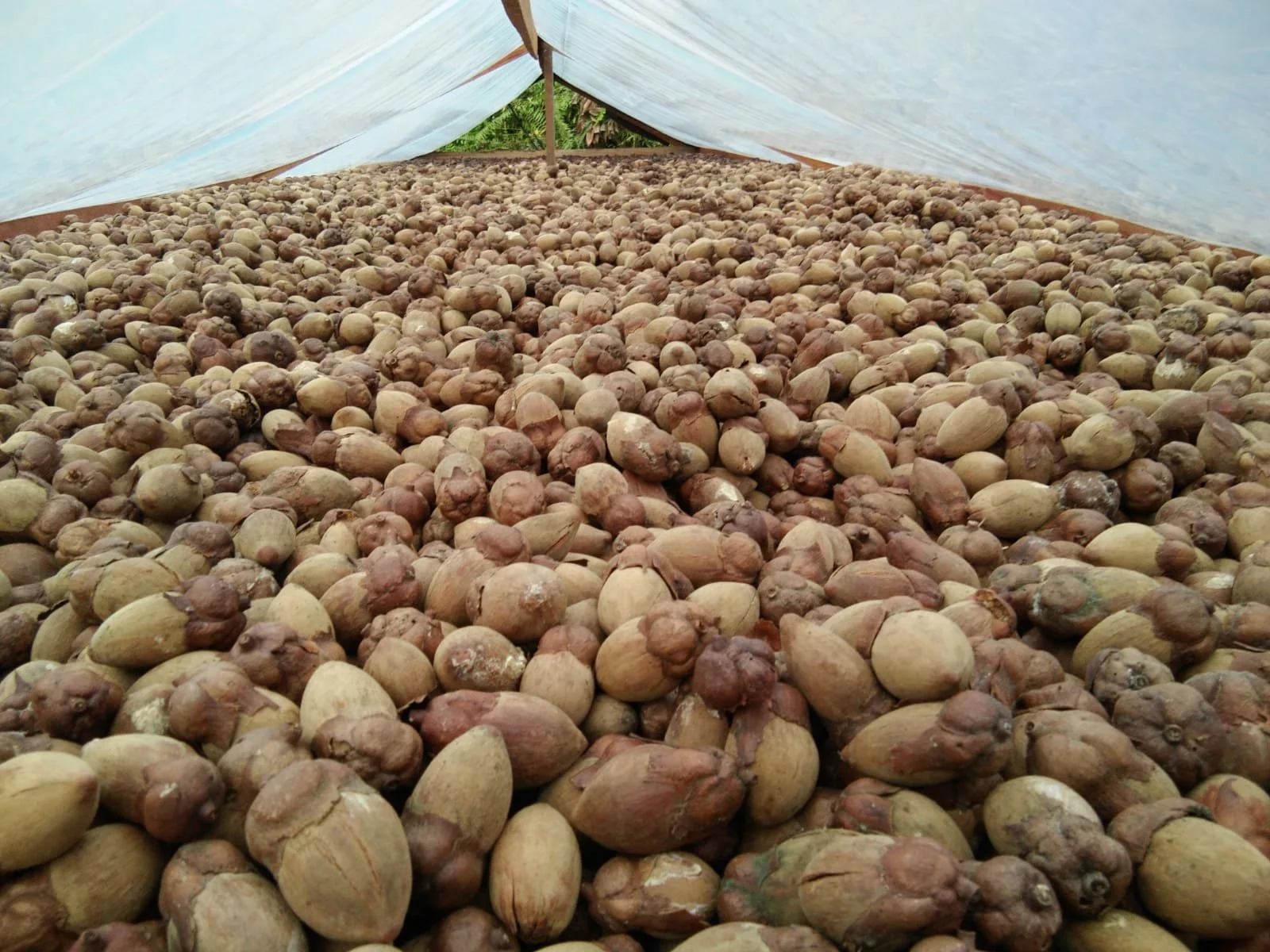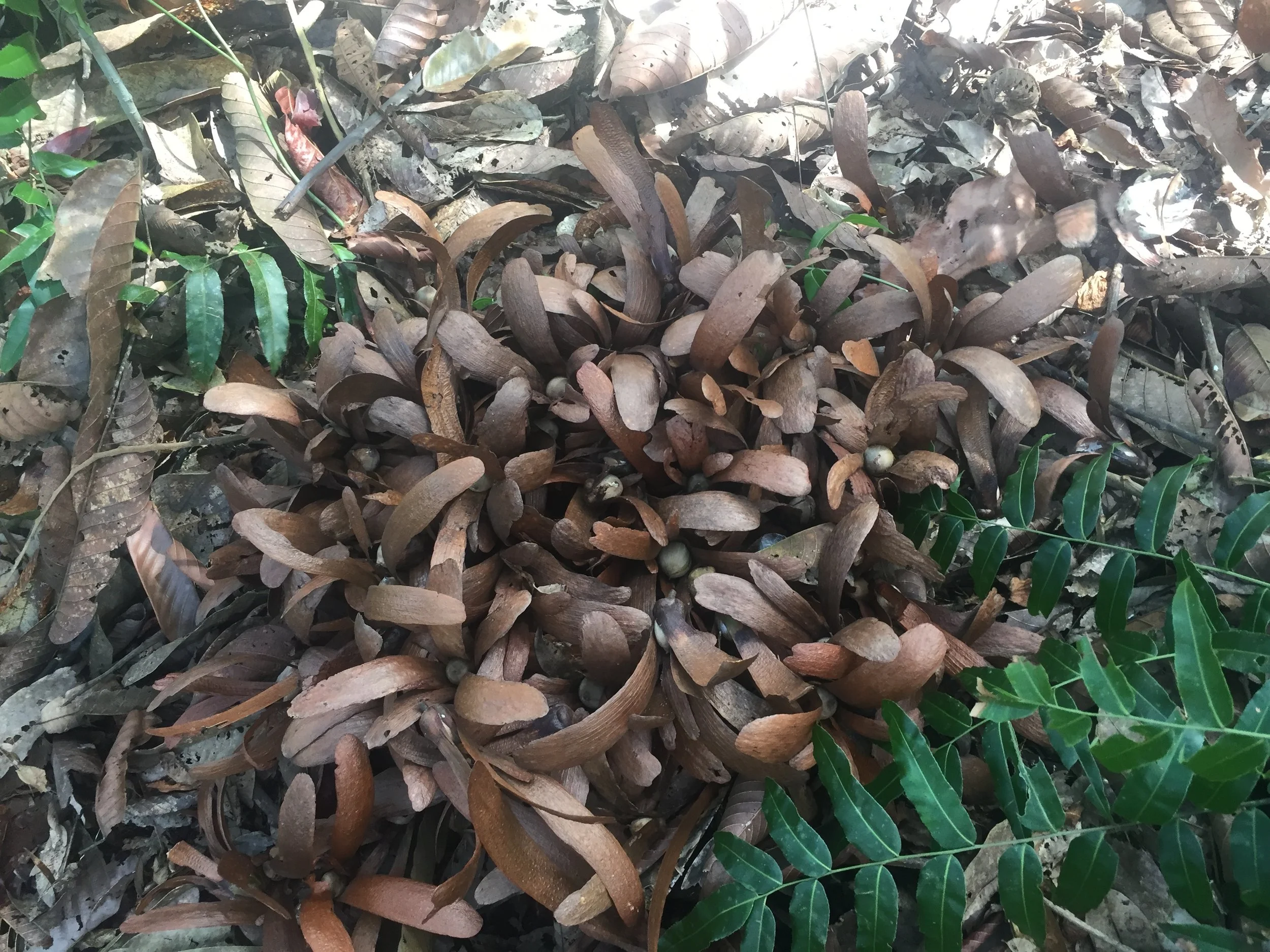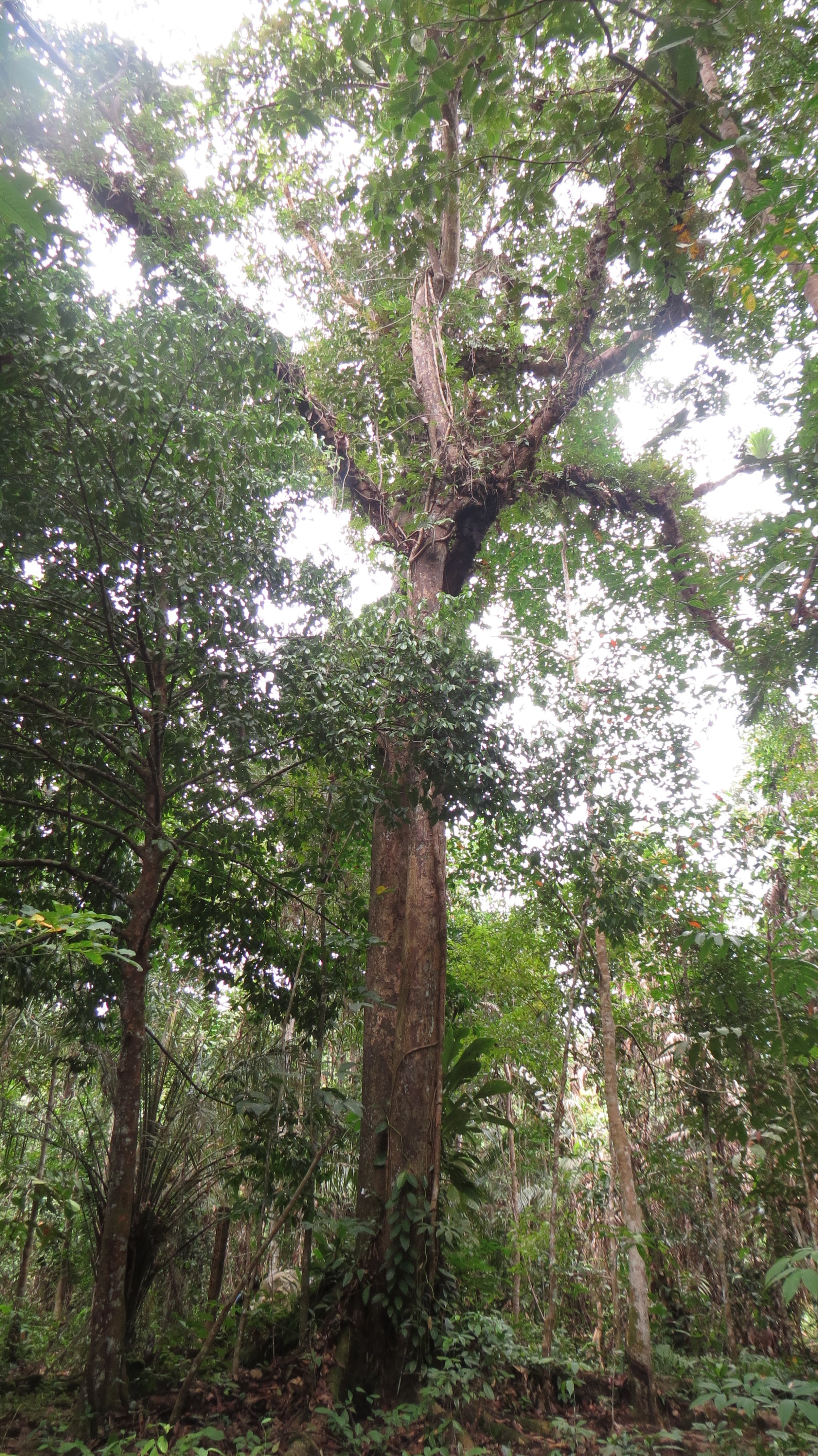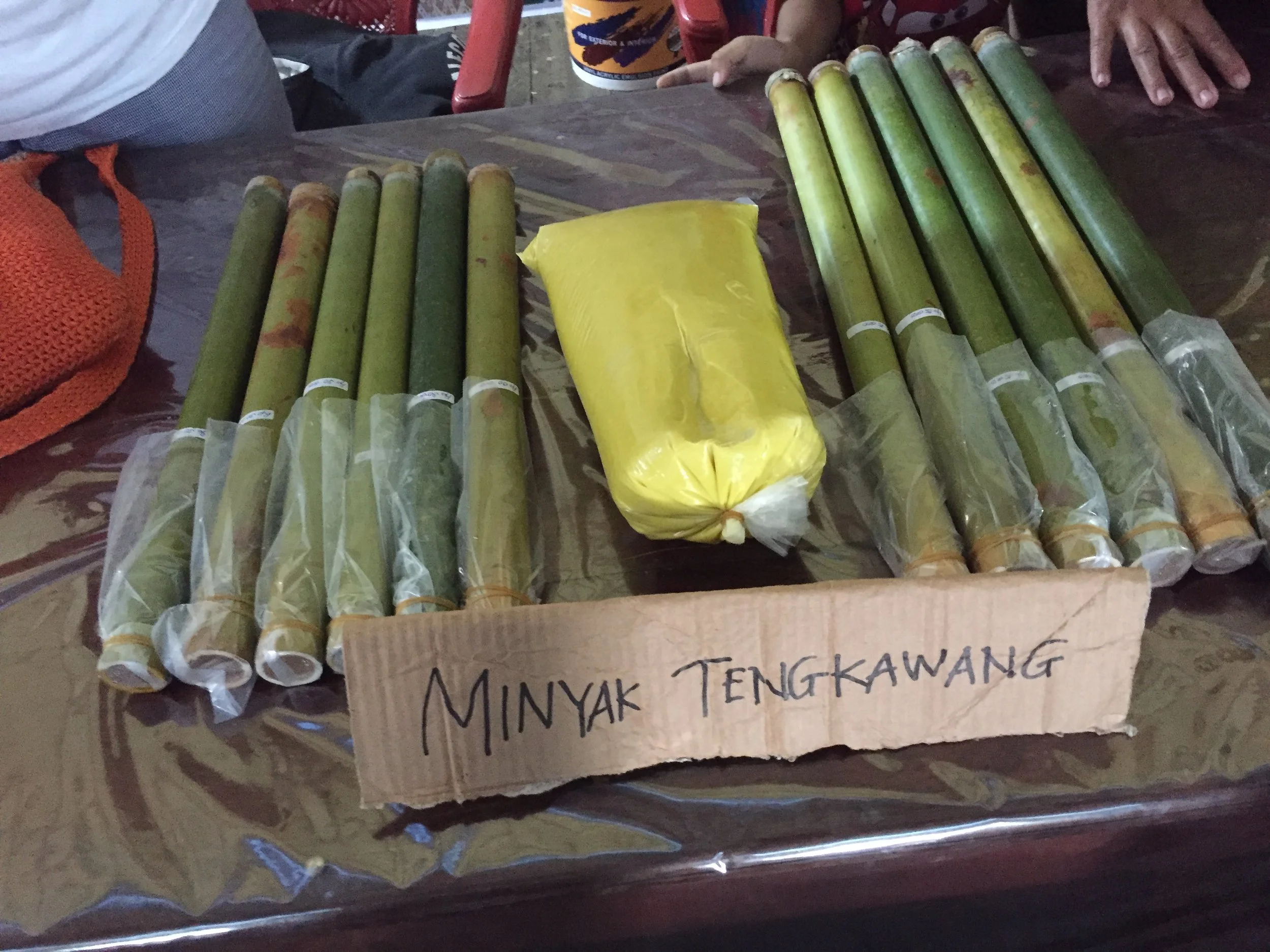Tengkawang (Shorea sp.)
Dried illipe nuts. Kalimantan, Indonesia. (Photo: Yayasan Riak Bumi)
By Taro Ringgit, Valentinus Heri and Joanna de Rozario
Background
Tengkawang (Shorea sp.) is a Dipterocarp Forest tree that is indigenous to Kalimantan and is listed on the IUCN Red List of Threatened Species. These trees yield fruits that resemble nuts, thus the name illipe nuts. Illipe has been used by local and indigenous populations for generations. Illipe is important in the spiritual, cultural, economic, and environmental life of local and indigenous peoples (Huri, Syolihin & Rikado, 2019). Illipe is a tree that may be used in a variety of ways. Illipe has and continues to have a wide range of uses. Illipe wood is frequently utilised in the construction of buildings. Traditionally, though, only fallen illipe trees were utilised for this. However, in other places, old, ineffective trees were also felled to make way for new homes. The illipe tree's leaves are processed into natural dyes, which give the Dayak Iban handwoven traditional ceremonial fabric known as pua kumbu a yellow tint. The sap of the tree creates a resin that is used to seal boats. Illipe butter is used both in the home and in medicine. The crushed nut pulp may be utilised as organic animal feed, plant fertilisers, and a biofuel alternative for smoking illipe nuts.
The Dayak indigenous populations of Kalimantan on the island of Borneo have long processed illipe nuts into butter. The outer shell of the nuts is peeled before they are sundried for a week. The nuts were smoked instead of dried for two to three days in the past. This procedure, however, causes the illipe butter to smell smoky. After being dried, the nuts were traditionally crushed using a wooden pestle and mortar. More recently, the sundried nuts are pulverised in a machine before being moved to a tank and steamed for an hour and transferred to a manual pressing machine and crushed for extraction of the oil. The oil is then preserved in bamboo vessels, where it will harden into illipe butter over the course of three days. The illipe butter may be stored for a year in these bamboo vessels.
Fallen illipe nuts on the forest floor of Dusun Sahan. (Photo: MYTransform)
Traditionally, illipe butter was produced from the nuts and utilised in cooking. The butter from the illipe tree is said to have therapeutic benefits. It was also once used in oil lamps. Presently, illipe butter is used to make lip balms, moisturisers, biscuits, and other value-added products in the cosmetic and confectionary industries, providing economic prospects for local communities that sell illipe nuts and butter.
Since generations, Illipe nuts have been traded in Kalimantan. Illipe trees are abundant in West Kalimantan's forests and produce a good seasonal (or yearly) production. Illipe butter is utilised in the confectionery and culinary industries as a cocoa butter equivalent (CBE) similar to shea butter, mango butter etc
In West Kalimantan, large forest and agroforest areas are available with large population of various types of illipe. Furthermore, Indonesian state policy and legislation, through its social forestry programme, promotes local communities' access to and ownership of forest and its resources, including illipe.
Illipe trees have been planted by Dayak people for generations. Trees are often planted in communal agroforests and privately owned plots. Local communities frequently utilise it to establish boundaries and demarcate property ownership. Illipe nuts that have fallen to the ground are commonly collected by community members. Illipe nuts that are germinating, on the other hand, are not allowed to be harvested and must be left to develop in the forest. This is a simple traditional practice to sustain the illipe resource. It takes six to eight years for an illipe tree to mature and bear fruit. Once every three to five years, the illipe is harvested during the monsoon season, which runs from December to February. There is, however, a yearly illipe season in Desa Sahan, Bengkayang regency. Collectors are predicted to be able to gather 80 kg of wet illipe nuts per day during the illipe season. After that, the nuts are dried. After drying, the weight of the nuts is decreased by roughly 40% (Karyono, Dwiprabowo, & Purnama, 1994).
Illipe has provided a substantial part of the average yearly revenue received by communities in Desa Labian and Desa Sahan in West Kalimantan, according to research conducted by MY Transform in 2020. According to Indonesian poverty criteria, these communities have a high estimated percentage of poverty, with 34 percent in Desa Labian and 19 percent in Desa Sahan. Furthermore, the major monthly source of revenue from the sale of rubber and vegetables, is insecure and susceptible to weather, illnesses, and infestations, particularly the latter. Illipe is Desa Labian's and Desa Sahan's most lucrative seasonal (every three to five years) source of revenue. It also contributes to Desa Sahan's annual revenue. In addition, illipe provides an income safety net when communities face a poor crop or crop failure caused by draught, floods or crop infection. Illipe also provides additional income to communities for planned or unexpected expense i.e., a wedding or higher education or a death, ailment, or medical emergency.
Illipe nursery. The rehabilitation of 1,000 illipe trees in 2020 and xx in 2022 conducted by the community of Dusun Ngaung Keruh and assisted by Yayasan Riak Bumi for the future generation. (Photo: Yayasan Riak Bumi)
The major buyer and distributor of illipe is PT Wilmar Cahaya Indonesia (PT WICA) that owns the largest mill in the region. PT WICA’s mill can process 120 tonnes of illipe nuts each day. PT WICA buys a range of illipe species from agents across West Kalimantan who is able to supply a minimum of 50 tonnes of illipe. PT WICA, on the other hand, will only run its mill if it has a minimum supply of 3000 tonnes of illipe. Consequently, it will only operate its mill during the masting season. However, PT WICA is presently upgrading its facilities, with the goal of purchasing illipe on a yearly basis.
The assistance from INTAN[1] and Jaringan Tengkawang Kalimantan (Kalimantan Illipe Network) has enabled Kelompok Usaha Perhutanan Sosial (KUPS, Social Forestry Enterprise Group) Tengkawang Layar from Desa Sahan to establish and operate a semi-automated mini mill. The machines have a production capacity of 100 to 200 kg of dry illipe nuts a day that generates 25 to 50 kg of butter respectively. The organisation and INTAN were able to acquire dried illipe nuts at a reasonable price, allowing the local communities in Desa Sahan to earn a fair living. In addition, a village social enterprise, Kelompok Bunga Layar has developed value-added products including food and candles from KUPS Tengkawang Layar's illipe butter, with the assistance from INTAN as well. Yayasan Riak Bumi on the other hand provides assistance for communities in the Kapuas Hulu regency i.e., Desa Labian. It began aiding the community by purchasing illipe butter and assisting in the development of products such as lip balm, shampoo bar, and body wash which is still in its early stages, in order to build local demand for illipe butter. Yayasan Riak Bumi is presently assisting the communities in Desa Labian on the rehabilitation of illipe trees. Furthermore, they are exploring drying and storing techniques of illipe to ensure better quality and longer shelf life of the illipe nuts and facilitating the sales of illipe nuts and butter. There are two other know mini mills in the district of Sintang and more mini mills are planned for development in the district of Landak, Malawi and Kapuas Hulu.
The illipe tree in the figure above is more than 50 years old and it is located in Dusun Ngaung Keruh, Desa Labian, Kapuas Hulu Regency, West Kalimantan. The Dayak communities have been planting illipe tress for generations, not only to utilize parts of the trees but also to mark boundaries and designate ownership of land. (Photo: Yayasan Riak Bumi)
Challenges and issues
The main challenge that the communities are now facing in relation to illipe production is inconsistencies in the supply base to give illipe purchasers with an annual supply because illipe is seasonal. Due to the inconsistencies in availability, the yearly illipe market in Indonesia is thus restricted to niche markets. Illipe butter will not be able to penetrate the mainstream market in Indonesia and abroad until it can deliver a regular supply of illipe, unlike other cocoa butter equivalents (CBEs) such as shea butter, which has an annual production.
Illipe butter is utilised in the confectionary industry. Due to inconsistencies in availability, a major confectionary brand’s product development department recently withdrew illipe butter from its product recipe. Other brands may follow suit, having a significant detrimental influence on illipe demand and, as a result, illipe prices at the community level. The decrease of illipe prices leads to abandoning of illipe nuts on the forest floor and eventually felling of illipe trees for their wood, which has a higher although short-term economic value.
Because the price of illipe declined as a result of legislation prohibiting the export of illipe nuts, the price of illipe wood became much more enticing, and the number of illipe trees decreased (Heri et al., 2020). The wood was used to construct residences, swiftlet motels, and floating cottages. Illipe wood costs between IDR 300,000 and IDR 600,000 per cubic metre, providing a quick yet significant revenue (Heri et al, 2020). As a result, low illipe nut prices pose a major danger not only to illipe tree conservation and the surrounding forest, but also to villagers' socio-economic safety nets and the industry's long-term or sustainable supply of illipe. In light of this, the call for the industry to think more carefully about the long-term effects of short-term price fixing has merit.
The low and unpredictable economic worth of illipe, as well as the lack of conservation laws and regulations in existence in West Kalimantan, are the greatest threats to the species' environmental sustainability. Both make it easier to down illipe trees indiscriminately for other purposes and short-term profits. The Minister of Agriculture's Decree Number: 54 / KPTS / UM / 2/1972 designated the illipe as a protected species in 1972. Later, the Government Regulation of the Republic of Indonesia Number 7/1999 backed up this decree, declaring 10 illipe species in Kalimantan and three in Sumatra to be protected species (refer to Annex2). However, the protection and conservation of illipe was revoked. Members of Jaringan Tengkawang Kalimantan highlighted the problem in a series of workshops where key government entities were invited to discuss issues related to illipe conservation and protection. Due to a lack of protective legislation and regulations, the network is afraid that illipe trees would be felled for other purposes by communities and loggers alike. To maintain environmental sustainability, a multiple land use landscape strategy is necessary which includes social forestry with illipe development, as well as illipe regeneration and conservation by communities and other stakeholders.
Oil extracted from illipe nut are traditionally stored in bamboo vessels and left to harden into the form of butter, with a shelf life of one year. (Photo: MY Transform)
Moving Forward
In moving forward, among other is supporting debates on fair pricing and enhancing conservation laws and regulations through the Kalimantan Illipe Network. It's also vital to have an inventory and map of illipe to give a baseline for conservation and production demands. Furthermore, the main concern in relation to the economic sustainability of illipe particularly in order not just to develop niche markets but to penetrate the mainstream market i.e., cocoa butter and other cocoa butter equivalents is the consistency in the supply of illipe. Illipe is mainly harvested once every four to five years. The key is to develop better storage facilities for illipe nuts and butter. In addition, to explore developing illipe hybrids that can provide an acceptable annual yield. Economic sustainability is also stunted by the unexplored opportunity of the Indonesian market. Exploring the local market is presently stalled by local government requirements and approvals. Illipe, however continues to thrive as a niche sector in the cosmetics business. Therefore, consistent illipe supply is required in the long run, as illipe demand is predicted to rise.
Green investment by the public and private sectors in illipe development has begun and will require more assistance. This includes illipe regeneration, enhanced storage and manufacturing facilities, skills training, and illipe promotion and marketing. Finally, working together to build a sustainable and responsible upstream and downstream supply chain to guarantee that all stakeholders, particularly with those involved in the manufacturing and sale of illipe and its by-products.
The Kalimantan Illipe Network, as well as its members from NGOs, business and public sector institutions, and communities, play a key role in fostering illipe initiatives. Illipe has offered local communities with a sustainable livelihood alternative based on its people and natural resources, which has the potential to develop through combined interventions from communities, government, NGOs, and the commercial sector.
Click here to download a summary table of the case study.
[1] Institut Riset dan Pengembangan Teknologi Hasil Hutan is a non-profit institution that aims to increase and develop the value of forest products via research and technological development.
References
MY Transform. 2021. Illipe and Communities: Sustainable Livelihood Assessment of Illipe West Kalimantan Indonesia. pp. 60. Available here.





